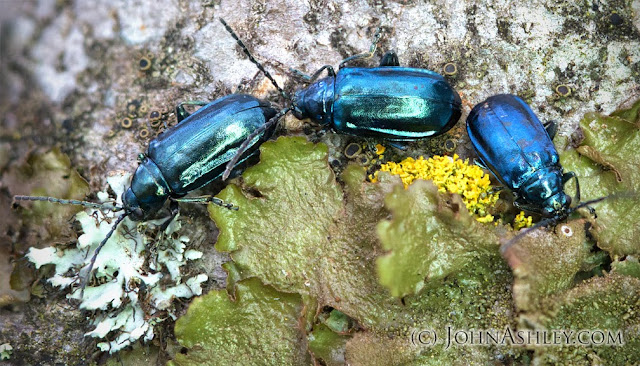 |
| Tiny, iridescent blue and green Alder Flea Beetles on the bark of my alder tree |
Living this far into the great white north, we've never had a problem with fleas on our dogs. But this year we have fleas on our trees instead. Our new fleas are small but very handsome, in shimmering shades of iridescent blue and green.
A clump of trees along the lakeshore is currently enduring an outbreak of Alder Flea Beetles (Macrohaltica ambiens or Altica ambiens, depending on who you read). Flea Beetles are small leaf beetles (less than 1/4 inch long) that sport enlarged femurs on their hind legs - muscular thighs that are used to leap away from danger. I pestered a few of our adult beetles long enough to verify that, indeed, they are excellent leapers.
 |
| Alder Flea Beetle larvae on a leaf, including one with a fungal infection (whitish area) |
The larvae spent a several weeks eating almost every single leaf in this clump of trees, leaving mostly brown leaf skeletons blowing in the wind. In August they all crawled down out of the trees, headed uphill, and disappeared into the soil to pupate into adults.
In September, the adult beetles started showing up in the same alder trees and feeding on leftover and replacement leaves. They numbered into the dozens per smallish tree, but now that it's October the adults are starting to disappear again, back into the soil for winter. They'll emerge in early spring, mate, and lay their eggs in the soil around these trees.
For reasons unknown, these infestations only last for a few years, and the alder trees seem to suffer only minimal damage. Fungal attacks on the larval seem to play a role in checking the beetle outbreaks, and they don't spread very far because most Flee Beetle species only feed on a small handful of closely-related host plants. Some are beneficial as well, including three species of Flea Beetles that were successfully introduced into eastern Montana and South Dakota as biological control agents against leafy spurge, an invasive non-native forb.
While my Alder Flea Beetles are just a temporary nuisance, other Flea Beetle species can cause considerable damage to western crops, especially rapeseed and canola. There are also Potato Flea Beetles (potato, tomato, nightshade family), Apple Flea Beetles (primrose, grape, crabapple), Willow Flea Beetles (willows), and Cabbage Flea Beetles (wide range of cruciferous plants), among many others.
Now if I could just find a Cabbage Flea Beetle that specializes on my gastero-nemesis, cauliflower, I'd consider that one to be among the highly beneficial species.

